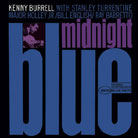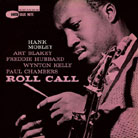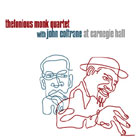![[SoundStage!]](../sslogo3.gif) The Vinyl Word The Vinyl WordBack Issue Article |
November 2006 Found on Vinyl: Kenny Burrell, Hank Mobley, and the Thelonious Monk Quartet with John Coltrane Sometimes I ponder what Waldo Selmon would think were he still alive about the widespread uses of his famous, albeit unintentional, invention: polyvinyl chloride, PVC, vinyl. His accidental discovery took PVC from a brittle, unusable compound and transformed it into a malleable and highly desirable one in 1926 -- and hence usable for everything from shoe soles to plumbing pipe. His work contributed to PVC’s becoming the second-most common plastic in use today. One of its main advantages is that PVC is simple to produce and inexpensive to make, consisting of nothing more than a few additives, petroleum, and sea water. Mix those ingredients together properly and, voilą, you get vinyl. My guess is that Selmon would smile, nod his head, and then go back to work. I do know what Peter Goldmark would think if he too were alive today. It was Goldmark, while working for CBS in 1948, who took Waldo Selmon’s invention and modified it, turning it into the foundation for the long-playing record that went on to become the main source for consumer music purchases for nigh on 50 years (and counting). So I believe he would be thrilled to no end that even well into this digital age people are still seeking out his invention to provide listening pleasure. Folks have spent the better part of those 50 years attempting to improve on Goldmark's and Selmon’s ideas for the vinyl record. Some have been unmitigated disasters -- like RCA’s ill-fated Dynaflex (aka the Dynafloppy) -- while others went on to become the gold standard -- JVC’s now-lost vinyl formula of the mid-to-late 1970s. Classic Records has done their fair share of homework on this subject as well. The result has been their own formula, Quiex SV-P 200-gram vinyl, which they’ve put to excellent use on a wide range of musical genres. In my estimation, it’s their reissuing of the classic Blue Note catalog that stands out over all their other endeavors, and they pretty much cover the musical spectrum. Trying to find, let alone afford, mint-condition original Blue Note LPs is impossible for the average consumer. Thankfully, Classic Records is correcting that situation by using the original master tapes as sources for their lovingly reissued LPs. Three examples of Classic Records' ongoing Blue Note reissue program came my way: a mono version of Kenny Burrell’s Midnight Blue [Classic/Blue Note 4123], a stereo version of Hank Mobley’s Roll Call [Classic/Blue Note 84058], and Thelonious Monk Quartet with John Coltrane at Carnegie Hall [Classic/Mosaic 946-3-42811-1]. I’ve included this last title in the Blue Note category on the grounds that it was Blue Note that issued this newly found music on CD.
Burrell is joined on this album by the late tenor-sax great Stanley Turrentine, bassist Major (Mule) Holly, drummer Bill English, and conga player Ray Barretto. Together they weave their magic through a program that demonstrates just how closely linked the blues and jazz truly are. Burrell’s guitar work is the foundation, laying out a late-night, cool-blues vibe that will get you right in the mood. And Turrentine, whose debt to the blues is self-evident in any of his solos, works hand in glove with Burrell. It’s an album such as this that’ll teach even the most skeptical guitar jammer that his chosen instrument is as fully proficient at jazz as it is rock.
In case you're wondering, the 200-gram Quiex SV-P pressing of the stereo Roll Call is better than the 180-gram, which is certainly very good itself. From the separation of the notes to their decay into the recording acoustic, to the tactile realness of the instruments themselves -- especially Blakey’s drums -- all are better served on the new reissue. These are not night-and-day differences, but they are noticeable if your system’s up to it. So it only makes sense to have the best pressing available. Sorry guys and gals, but that's the way I hear it. This brings me to the final LP in this column, and a most important musical discovery. I consider it the musical equivalent of Howard Carter discovering King Tut’s tomb (minus all of the bad luck that followed). It’s the unearthing of a full album's worth of material documenting one of the greatest jazz quartets ever assembled -- a group that had, up till now, been more legend than fact, given the scarcity of recorded material to prove its existence. The Thelonious Monk Quartet with John Coltrane had a six-week stand at the old Five Spot in New York during the summer of 1957, and it is the stuff of legend. Everyone who was anyone dropped by for a listen. It seems that the only ones who managed to miss this engagement were recording engineers. Go figure.
First, let’s get this out in the open: This is not by any means an audiophile recording. It’s mono to start with and it was taped with the idea of radio airplay, so complete fidelity was not the prime concern. Neither Ahmed Abdul-Malik’s bass nor Shadow Wilson’s drums shine sonically, though Wilson’s cymbals shimmer like the real thing. Second, this is an analog transfer from a 24-bit/192kHz digital master made from the original 15" analog tapes using "Sonic Restoration, forensic editing, and pre-mastering by transfer master engineer Grand Mixer DT." (I didn’t make that last part up -- it’s on the LP jacket.) Why go analog to digital and back to analog? I don’t know. Maybe there was enough worry over the quality of the priceless tapes to warrant protecting them by making corrections in the digital domain, where they wouldn’t be putting the tapes in physical peril. With all these chits in the debit column, you might be asking why this LP is such a big deal. What makes it worth spending twice the cost of the CD? One listen, that’s all it’ll take for you to come to the realization that the CD compares to the LP about the same way a cassette would compare to the CD. That CD that you can pick up for about $12 is still only 16 bits/44kHz. At least the analog LP can take advantage of the 24-bit/192kHz source by reproducing everything on the tape. Still, that first listen will compel you to listen again and come to the realization that this LP sounds pretty darned good after all. It captured a particularly good night for both Monk and Coltrane. Monk sounds more buoyant and upbeat than he had in years, and Coltrane is at his mature, assured best. About the only negative I can come up with is that this album is far too short. You’ll definitely be left wanting more. Still, in comparison with what we had to document Monk and Coltrane’s time together, this is a godsend. Hackneyed expression though it may be, this really is one of those must-buy albums. Don’t, on any account, miss it. After collecting these three albums for a late listening session, slipping one of these nice, thick slabs of pristine vinyl onto whatever turntable the celestial big rig is using, and giving a good listen, I can just imagine Selmon and Goldmark popping whatever cold brew the heavenly bartender has on tap and grinning from ear to ear at what good use we’ve put to their inventions. Thanks, guys. We owe you a big, frosty one. May your invention continue to bring pleasure for another half-century. ...John Crossett |
|
![[SoundStage!]](../sslogo3.gif) All Contents All ContentsCopyright © 2006 SoundStage! All Rights Reserved |
 Midnight Blue
is, to put it mildly, a stunner. It’s one of those rare albums that can pull double
duty -- perfect for either late-night solo listening or when wooing that special someone.
When I compared the mono Classic Records 200-gram Quiex SV-P vinyl with my near-mint
stereo DMM copy, it was no contest. The Classic Records LP was better in every possible
way. First off, mono is the way Blue Note’s recording engineer Rudy Van Gelder
preferred to mix his music. Even in mono, the musicians stand apart from one another.
Next, the music is reproduced with far more subtlety, grace, and proper tonal balance via
the Classic LP. The DMM version is all bright, brittle, brash, and in your face. The noise
floor via the Classic LP was noticeably lower too, allowing for a blacker, emptier
background. The Classic LP was also thicker and flatter.
Midnight Blue
is, to put it mildly, a stunner. It’s one of those rare albums that can pull double
duty -- perfect for either late-night solo listening or when wooing that special someone.
When I compared the mono Classic Records 200-gram Quiex SV-P vinyl with my near-mint
stereo DMM copy, it was no contest. The Classic Records LP was better in every possible
way. First off, mono is the way Blue Note’s recording engineer Rudy Van Gelder
preferred to mix his music. Even in mono, the musicians stand apart from one another.
Next, the music is reproduced with far more subtlety, grace, and proper tonal balance via
the Classic LP. The DMM version is all bright, brittle, brash, and in your face. The noise
floor via the Classic LP was noticeably lower too, allowing for a blacker, emptier
background. The Classic LP was also thicker and flatter.  Hank
Mobley’s Roll Call has been previously reissued in stereo by Classic Records
on 180-gram vinyl. I bought a copy when it was released, as this is one of Mobley’s
finest efforts. It should be on the shelves of any serious jazz collector. The music
sounds clean, clear and incisive. It should, given that Mobley’s tenor sax had help
from the likes of Freddie Hubbard on trumpet, Paul Chambers on bass, and the great Art
Blakey on drums. Talk about your all-star lineups! These boys punch out six Mobley
originals, all excellent examples of pure hard bop. It’s a shame that Mobley was
never awarded the distinction his music earned him during his lifetime. Maybe this reissue
will go some way toward rectifying that situation.
Hank
Mobley’s Roll Call has been previously reissued in stereo by Classic Records
on 180-gram vinyl. I bought a copy when it was released, as this is one of Mobley’s
finest efforts. It should be on the shelves of any serious jazz collector. The music
sounds clean, clear and incisive. It should, given that Mobley’s tenor sax had help
from the likes of Freddie Hubbard on trumpet, Paul Chambers on bass, and the great Art
Blakey on drums. Talk about your all-star lineups! These boys punch out six Mobley
originals, all excellent examples of pure hard bop. It’s a shame that Mobley was
never awarded the distinction his music earned him during his lifetime. Maybe this reissue
will go some way toward rectifying that situation. Shortly after Monk and
Coltrane finished their time at the Five Spot, the Voice of America radio network put
together a jazz concert at Carnegie Hall to be broadcast over the airwaves. Monk’s
quartet was invited to be a part of that show, and, fresh off that highly successful and
critically acclaimed earlier engagement, Coltrane agreed to join for this one final show.
Shortly after Monk and
Coltrane finished their time at the Five Spot, the Voice of America radio network put
together a jazz concert at Carnegie Hall to be broadcast over the airwaves. Monk’s
quartet was invited to be a part of that show, and, fresh off that highly successful and
critically acclaimed earlier engagement, Coltrane agreed to join for this one final show.